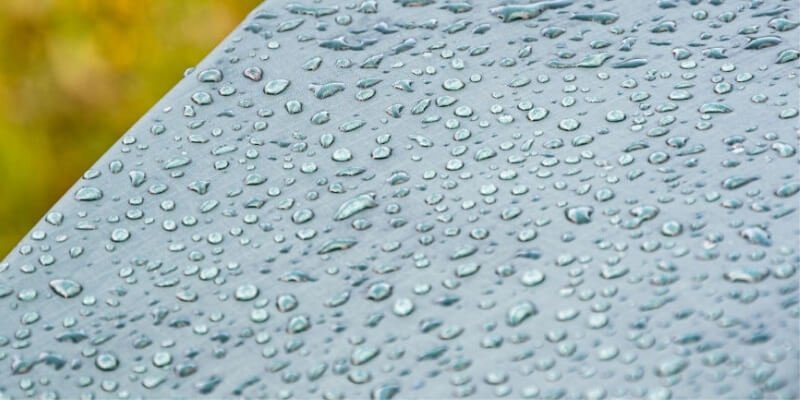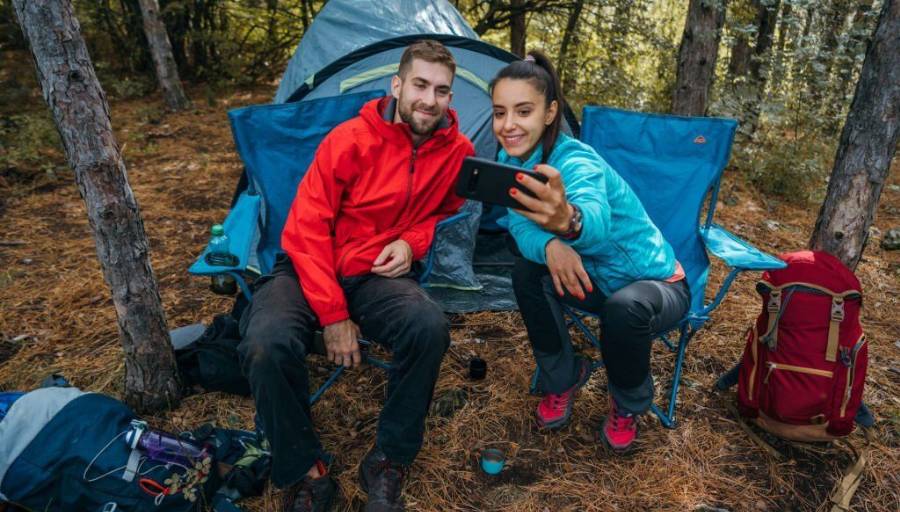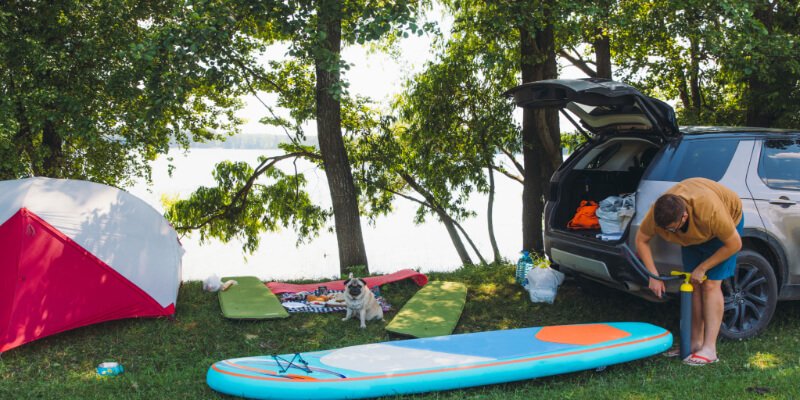How to Dry a Tent Fast and Easy

Proper tent care is crucial for ensuring a smooth and enjoyable camping trip. After your adventure, it’s important to dry your tent thoroughly before storing it, as any lingering moisture can lead to mold growth. Not only does mold mar your tent’s appearance, but the spores can pose a serious health risk.
We’ll take you through effective steps to quickly and efficiently dry your tent after use. By following these tips, you can preserve the longevity of your gear and ensure it’s clean and safe for your next outdoor journey.
How to Dry Your Tent on the Campsite
The campsite is the best place to dry your tent. Because you can pack up your dry tent and put it on the shelf at home. Let’s see how to dry a tent on the campsite quickly and effectively! You usually only need a few minutes for this. We promise you: it’s worth it!
Choose a good pitch for your tent
This is the simplest technique. You can recognize a suitable parking space by these features:
- The location should not be situated in a low-lying area or covered with fresh moss.
- In the morning, the sun shines on the campsite.
- A bit of wind is blowing on the pitch.
To ensure your tent dries quickly in the morning sun on the day of departure, choose a compact tent that comfortably suits your needs. Set it up in direct sunlight early in the morning to allow it to dry efficiently before packing up.
Check the weather report on the day of departure
Good planning can save you effort when packing up your tent. Check the weather forecast for your departure day. If the sun is expected in the morning, leave your tent up a bit longer to let the sunlight and breeze dry off the morning dew, often within 30 minutes. If rain is forecast, pack your tent before it starts—ideally just before the first drops fall.
Open all windows and doors

No one enjoys standing around waiting, so the goal is to dry your tent as quickly as possible. Start by opening all windows and doors to create a draft. This will allow the interior to dry faster, especially after cold nights when condensation from your breath may have collected on the tent walls.
With the doors open, the inside of the tent dries quickly. For even faster results, separate the inner tent from the outer tent to improve airflow. If there are any puddles on the tent floor, use a small microfiber towel to wipe them up. Microfiber absorbs more moisture than cotton, is lightweight, and dries rapidly.
Dry seams, floor, guy ropes, poles & pegs
Once the tent walls are dry inside and out, you’ve completed about 90% of the process, but the remaining 10% is just as crucial. Don’t forget to dry the bottom of your tent floor, as ground moisture can still accumulate even on dry days. Flip the tent over, exposing the floor to the sun and wind.
If you’re using a tarpaulin, weigh it down with gear to prevent it from being lifted by the wind. Tent seams and guy lines typically take longer to dry, so double-check them before packing up. Also, ensure that your tent pegs and poles are dry to avoid rust, and clean off any soil clinging to the pegs.
Use a clothesline that works wonders
It rains and the tent field is damp. A line stretched between two trees is an excellent tool for drying your tent. However, we recommend that you always have a small roll of paracord in your luggage instead of a clothesline so that you can use paracord for many other purposes. For example, you can use it to make your tent stormproof in a storm.

PARACORD PLANET 100′ Hanks Parachute 550 Cord
Does your campsite have a drying room?
Some campsites have a drying room. Here, campers can dry their laundry and equipment. Often there are also clotheslines and stands in the drying room to hang up wet tent. However, the drying room is a great place to dry your tent before you leave for breakfast in town or load the car.
How to Dry Your Tent at Home
Pack your wet tent correctly
If it rains while taking down the tent, start by unhooking and packing the dry inner tent while the wet outer tent remains set up. Shake out the outer tent to remove excess water, using a soft microfiber cloth to blot any remaining moisture without damaging its coating. Pack the tent loosely, ideally spreading it out in your trunk. Keep the wet outer tent and dry inner tent separate to maintain the inner tent’s dryness
If the tent goes in a pannier, unzip the bag to allow moisture to escape, avoiding contact with rust-prone items. When packing in a backpack, use a dry bag for the wet tent to protect your other gear. Finally, remove the tent from the packsack within 24 hours to prevent mold growth.
Dry your tent outside in good weather

Did you have to pack a wet tent? No problem! In good weather, you can easily dry it outside at home. If the tent is muddy, clean it first before drying.
The safest method is to re-pitch the tent in your garden or a nearby park, which allows it to dry effectively, including the interior. Small tents, air tents, and pop-up tents can be set up in just a few minutes. If you’re not keen on putting it up again, simply spread the tent out on dry ground, turning it occasionally until all sides are dry.
In direct midday sun and wind, your tent can dry in just a few minutes, while shade under large trees can delay drying for hours. UV radiation from the sun kills mold spores, so if your tent has been damp for an extended period, sun exposure is beneficial—just an hour is often enough.
To optimize drying, place the tent on a paved surface rather than lush grass, which can retain moisture. Hanging the tent on a clothesline or rotary dryer is even more effective, as it allows both sides to dry simultaneously. Make sure to arrange the fabric so that water doesn’t pool in any folds. In a pinch, you can also use a balcony railing, hedge, or bush for hanging, but be cautious of sharp branches!
Dry your tent indoors in bad weather
If it’s rainy, cloudy, or cold, drying your tent indoors is often better than doing so outside. The ideal environment is a heated room above 20 degrees Celsius with humidity below 55%, such as a boiler room, living area, or winter garden. Avoid damp spaces like attics, unheated basements, garages, and barns.
To hang your tent, use clothes racks, chairs, or clotheslines stretched between doorknobs, as well as banisters or shower curtain rods. If the tent is very wet, place a towel underneath to protect surfaces from dripping water.
Since indoor drying lacks sun and wind, turn the tent every few hours until it’s fully dry. Open windows or turn on heating to speed up the process, and keep doors open in small rooms for better airflow.

Speed up the drying process with a fan
Fan heaters can be effective on the campsite for drying your tent. A quick blast of heat can make the inner tent reasonably dry again, but ensure you know how to use electrical devices safely in humid conditions.
To accelerate the drying process, consider using a dehumidifier, which increases evaporation rates. This allows your tent to dry even faster. Pairing the dehumidifier with a fan can significantly boost airflow and evaporation.
For optimal results, use a standard room fan with a swivel function to ensure airflow reaches every corner of the tent. A ceiling fan is even better, as its large rotor blades circulate air throughout the room. The quickest option is a fan heater, but be cautious to keep the air temperature below 60 degrees Celsius. You can easily check this with a thermometer.

Amazon Basics 1500W Tent Heater
Use cotton bags instead of plastic
Once dry, store your tent in a cotton sack. They are breathable, and any residual moisture that is present can escape. This prevents nasty smells! If your tent comes with a plastic pannier, get a suitable cotton sack for storage. A practical side effect is the packsack comes with a new tent often too small. We see this with large tunnel tents and family tents. Since there are cotton sacks in all sizes, you will find a model that comfortably fits your tent. Just measure how big your rolled-up tent is.

MISSLO Dust-proof Cotton Pouch Bag
How to Keep Your Tent Dry
Ideally, preventing your tent from getting wet in the first place is the best approach. You can achieve this through proper care and regular maintenance of your camping gear.
Put up the tent under a tree
This is a good idea, but not as good as it sounds. During short rain showers, it stays dry under the tree. However, prolonged rain penetrates through the foliage. And even hours later, thick drops of water fall from the treetop onto your tent.
Use a tent pad
I prefer to use the groundsheet under my tents. This practical layer protects the tent floor from sharp stones, ground moisture, and mud, helping to extend its lifespan and keep the floor clean and dry after camping. When I get home, I simply toss the mat in the washing machine on a low temperature and then hang it on the clothesline to dry.
Waterproof your tent before camping
The easiest way to waterproof your tent is by using a spray. These sprays prevent the tent fabric from absorbing water. The water just rolls off and flows to the ground. Impregnation sprays are cheap, versatile, and very effective.
Do not cook in the tent
Even if it seems tempting to cook in a tent in cold weather, cooking with a gas stove creates a lot of water vapor. It then condenses on the cold tent wall and puddles form on the tent floor. Better places to cook are pavilions open on all sides and natural shelters such as trees with dense foliage. You can also carry a portable oven for camping instead of cooking in a tent.
Heat the tent with a tent heater
This tip is clearly in the direction of glamping and heating tents with a tent heater – put it mildly – not particularly energy efficient. But it works. The heat increases the rate of evaporation in the tent. The tent and your equipment dry faster and annoying morning dew does not even settle on your tent wall.
Warm air holds more moisture than cold air, so it’s essential to ventilate your tent. If the warm air cools down without proper airflow, condensation will form, creating dampness inside.
Bonus tip: How to Check Whether Your Tent is Really Dry
Water is relatively heavy, so a quick way to check if your tent is completely dry is to use a scale. Weigh your tent before your camping trip and then again afterward.
A bathroom scale or luggage scale works well for large, heavy family tents made of cotton. For smaller, lighter tents, use a scale with finer resolution, like a kitchen scale or a handheld scale with a 10-gram resolution.
After drying, I usually check by feeling the fabric with my hands, and this method has always served me well. This tip is useful for campers who need to dry their tents under challenging conditions and want to ensure there are no hidden “moisture pockets” left.
Conclusion
Properly drying a tent can be a bit of a hassle, but it’s essential for maintaining its longevity and preventing mold, which can damage the fabric and pose health risks. The easiest method is to let the tent dry in the sun and wind right at the campsite. Utilize a good parking spot, keep doors open, use a groundsheet, and set up a clothesline for effective drying.
However, if it rains, you’ll need to dry your tent at home, ideally in warm rooms with humidity below 55%. You can use heating or a fan to aid the drying process. Do you know anyone who has lost a tent to moisture? Don’t let that be you! Take good care of your tent so you can enjoy many adventures together in the great outdoors for years to come.
FAQs
Can I put my tent in the tumble dryer?
We strongly advise against this! Heat and mechanical friction put a lot of stress on the tent fabric and its delicate coating. In most cases, your tent will still be intact after tumble drying. But its lifespan is shortened and breaks earlier than a tent dried gently.
Why do I have to dry a wet tent?
Dew and soil moisture can make your tent wet even on rain-free days. If you store the tent at home damp, you face these dangers:
- Mold: Cotton tents are prone to mold, but the dirt that sticks to synthetic fiber tents can also get moldy. When it has spread on the tent fabric, the tiny spores are everywhere. Mold is also difficult to remove. Often the tent is then ready for the bin.
- Hydrolysis: Water degrades cotton tent fabric over time. What hardly anyone knows: tents made of synthetic fibers also suffer from prolonged moisture. Hydrolysis makes your sensitive polyurethane coating brittle. The tent is leaking.
- Bad smells: A damp tent starts to smell at some point. Have you ever left your laundry in the washing machine for a few days after washing it? Then you know what we are talking about. So it’s important to dry your tent properly after camping.
How thoroughly do I have to dry a wet cotton tent?
Very thorough! Because natural fiber cotton is sensitive and quickly molds, mold stains, and bad smells when damp. Also, the cotton threads dissolve over time. Therefore, a cotton tent should dry before storage.
Why do I need to dry a polyester or nylon tent?
Synthetic fibers are more stable than cotton but suffer from prolonged moisture. The water-repellent coating of many tents is particularly at risk. Polyurethane becomes brittle at some point in the event of prolonged moisture. Then the tent is leaking.
Why does my tent get wet while camping?
Sure: when it rains, the tent gets wet. However, other causes are not quite as obvious. If it cools down significantly at night, morning dew will fall on the tent. In addition, the air you breathe can condense on the tent wall at night. Then in the morning, you will see small water droplets inside your tent.
How long does it take to dry a tent?
It depends on the tent and the weather. A small nylon tent stands in the sun and the wind dries in about 10 minutes on warm days. On the other hand, a large cotton family tent hanging on a clothesline in a dark garage in the cool autumn can take several days to dry.
Do you have any further questions? Just write us a short message.





